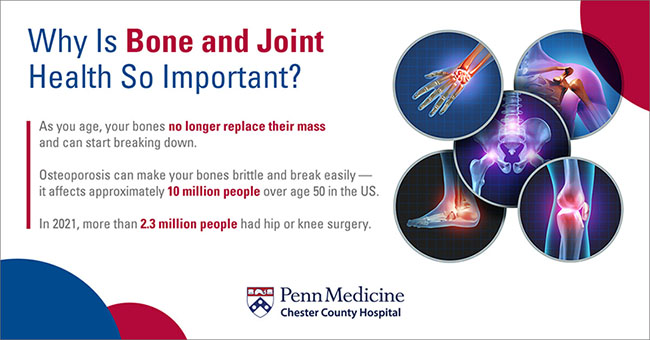
Whether you're walking to the car, sitting in your chair, or baking a loaf of bread, your bones make daily activities possible. That's why it's so important to think about your joint health and make small changes that can help protect it.

Here are 6 ways you can protect and improve your bone health.
1. Exercise Regularly
Exercising is good for your overall health — and different exercises can be specifically good for your bones, such as:
- Weight-bearing exercises like:
- Resistance exercises like:
- Weight lifting
- Lifting a medicine ball
- Squats or lunges
2. Get More Calcium and Vitamin D In Your Diet
Calcium can help keep your bones strong and dense — and Vitamin D can help your bones absorb and use that calcium. Try adding foods with calcium and Vitamin D to your diet, like:
- Calcium
- Low-fat and nonfat milk
- Yogurt
- Cheese
-
Vitamin D
- Milk
- Salmon, tuna and mackerel
- Other Vitamin D-fortified foods like some breakfast cereals or orange juice
3. Avoid Habits That Are Bad for Bone Health
While there are some activities that are good to do for your joint and bone health, there are also some habits you should avoid, like:
- Excessive drinking of alcohol
- Smoking cigarettes daily or a few times a week
- Hunching at your desk during work
Do you have questions about how you can prioritize your bone and joint health? Meet with a primary care provider or call 610-344-3451 to speak to one of our orthopaedics experts.
4. Preventing Falls — And Future Broken Bones
Fall prevention is a great way to think about your bones and avoid a problem before you have one. You can prevent falls and protect your bones by:
- Wearing rubber-soled, low-heeled, non-skid footwear that fully supports your foot
- Fall-proofing your house by limiting rugs and tripping hazards
- Using a cane, walker or wheelchair if your provider recommends it
5. Go to Physical Therapy (And Actually Do Your Exercises)
Physical therapy can be your best friend when it comes to bone and joint health. You might consider PT to help:
- Quicken your recovery — and prevent blood clots — after total joint replacement surgery like:
- Hip replacement
- Knee replacement
- Prevent future falls with PT exercises that improve your:
- Walking ability
- Strength
- Balance
- Endurance
6. Visit Your Primary Care Provider Each Year
Your primary care provider is a key part of your overall health — and your bone health, too. Your provider can:
- Ask you questions about your bone health and health goals
- Refer you to an orthopaedic specialist or physical therapist
- Help you identify other ways to improve your bone and joint health
Now that you know about these good habits, take this quiz to see if there's more you can be doing for your own bone and joint health!